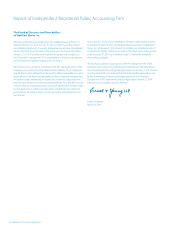Walmart 2014 Annual Report Download - page 52
Download and view the complete annual report
Please find page 52 of the 2014 Walmart annual report below. You can navigate through the pages in the report by either clicking on the pages listed below, or by using the keyword search tool below to find specific information within the annual report.
Nonrecurring Fair Value Measurements
In addition to assets and liabilities that are recorded at fair value on a recurring basis, the Company’s assets and liabilities are also subject to nonrecurring
fair value measurements. Generally, assets are recorded at fair value on a nonrecurring basis as a result of impairment charges. The Company did not
record any signicant impairment charges to assets measured at fair value on a nonrecurring basis during the scal years ended January 31, 2014, or 2013.
Other Fair Value Disclosures
The Company records cash and cash equivalents and short-term borrowings at cost. The carrying values of these instruments approximate their fair
value due to their short-term maturities.
The Company’s long-term debt is also recorded at cost. The fair value is estimated using Level 2 inputs based on the Company’s current incremental
borrowing rate for similar types of borrowing arrangements. The carrying value and fair value of the Company’s long-term debt as of January 31, 2014
and 2013, was as follows:
January 31, 2014 January 31, 2013
(Amounts in millions) Carrying Value Fair Value Carrying Value Fair Value
Long-term debt, including amounts due within one year $45,874 $50,757 $43,981 $50,664
8 Derivative Financial Instruments
The Company uses derivative nancial instruments for hedging and
non-trading purposes to manage its exposure to changes in interest and
currency exchange rates, as well as to maintain an appropriate mix of
xed- and variable-rate debt. Use of derivative nancial instruments in
hedging programs subjects the Company to certain risks, such as market
and credit risks. Market risk represents the possibility that the value of the
derivative nancial instrument will change. In a hedging relationship, the
change in the value of the derivative nancial instrument is oset to a
great extent by the change in the value of the underlying hedged item.
Credit risk related to a derivative nancial instrument represents the
possibility that the counterparty will not fulll the terms of the contract.
The notional, or contractual, amount of the Company’s derivative nan-
cial instruments is used to measure interest to be paid or received and
does not represent the Company’s exposure due to credit risk. Credit risk
is monitored through established approval procedures, including setting
concentration limits by counterparty, reviewing credit ratings and requiring
collateral (generally cash) from the counterparty when appropriate.
The Company only enters into derivative transactions with counterparties
rated “A-” or better by nationally recognized credit rating agencies.
Subsequent to entering into derivative transactions, the Company regularly
monitors the credit ratings of its counterparties. In connection with
various derivative agreements, including master netting arrangements,
the Company held cash collateral from counterparties of $641 million
and $413 million at January 31, 2014 and January 31, 2013, respectively.
The Company records cash collateral received as amounts due to the
counterparties exclusive of any derivative asset. Furthermore, as part of
the master netting arrangements with these counterparties, the
Company is also required to post collateral if the Company’s net deriva-
tive liability position exceeds $150 million with any counterparty. The
Company did not have any cash collateral posted with counterparties
at January 31, 2014 or January 31, 2013. The Company records cash
collateral it posts with counterparties as amounts receivable from those
counterparties exclusive of any derivative liability.
The Company uses derivative nancial instruments for the purpose of
hedging its exposure to interest and currency exchange rate risks and,
accordingly, the contractual terms of a hedged instrument closely mirror
those of the hedged item, providing a high degree of risk reduction and
correlation. Contracts that are eective at meeting the risk reduction and
correlation criteria are recorded using hedge accounting. If a derivative
nancial instrument is recorded using hedge accounting, depending on
the nature of the hedge, changes in the fair value of the instrument will
either be oset against the change in fair value of the hedged assets,
liabilities or rm commitments through earnings or be recognized in
accumulated other comprehensive income (loss) until the hedged item
is recognized in earnings. Any hedge ineectiveness is immediately
recognized in earnings. The Company’s net investment and cash ow
instruments are highly eective hedges and the ineective portion has
not been, and is not expected to be, signicant. Instruments that do
not meet the criteria for hedge accounting, or contracts for which the
Company has not elected hedge accounting, are recorded at fair value
with unrealized gains or losses reported in earnings during the period
of the change.
Fair Value Instruments
The Company is a party to receive xed-rate, pay variable-rate interest
rate swaps that the Company uses to hedge the fair value of xed-rate
debt. The notional amounts are used to measure interest to be paid or
received and do not represent the Company’s exposure due to credit
loss. The Company’s interest rate swaps that receive xed-interest rate
payments and pay variable-interest rate payments are designated as
fair value hedges. As the specic terms and notional amounts of the
derivative instruments match those of the xed-rate debt being hedged,
the derivative instruments are assumed to be perfectly eective hedges.
Changes in the fair values of these derivative instruments are recorded
in earnings, but are oset by corresponding changes in the fair values
of the hedged items, also recorded in earnings, and, accordingly, do not
impact the Company’s Consolidated Statements of Income. These fair
value instruments will mature on dates ranging from February 2014 to
May 2014.
50 Walmart 2014 Annual Report
Notes to Consolidated Financial Statements
























